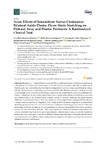Mostrar o rexistro simple do ítem
Acute Effects of Intermittent Versus Continuous Bilateral Ankle Plantar Flexor Static Stretching on Postural Sway and Plantar Pressures: A Randomized Clinical Trial
| dc.contributor.author | López-López, Daniel | |
| dc.contributor.author | Losa Iglesias, Marta Elena | |
| dc.contributor.author | Becerro-de-Bengoa-Vallejo, Ricardo | |
| dc.contributor.author | Palomo-López, Patricia | |
| dc.contributor.author | Calvo-Lobo, César | |
| dc.contributor.author | Rodríguez-Sanz, David | |
| dc.contributor.author | Martínez-Jiménez, Eva María | |
| dc.contributor.author | Díaz-Velázquez, José Ignacio | |
| dc.date.accessioned | 2022-02-01T11:31:45Z | |
| dc.date.available | 2022-02-01T11:31:45Z | |
| dc.date.issued | 2019-01 | |
| dc.identifier.citation | Martínez-Jiménez, E.M.; Losa-Iglesias, M.E.; Díaz-Velázquez, J.I.; Becerro-De-Bengoa-Vallejo, R.; Palomo-López, P.; Calvo-Lobo, C.; López-López, D.; Rodríguez-Sanz, D. Acute Effects of Intermittent Versus Continuous Bilateral Ankle Plantar Flexor Static Stretching on Postural Sway and Plantar Pressures: A Randomized Clinical Trial. J. Clin. Med. 2019, 8, 52. https://doi.org/10.3390/jcm8010052 | es_ES |
| dc.identifier.issn | 2077-0383 | |
| dc.identifier.uri | http://hdl.handle.net/2183/29519 | |
| dc.description.abstract | [Abstract] Postural balance and fall efficacy (self-perceived confidence in performing daily physical activities) have been found to be risk factors associated with falls in older adults. Stretching is one intervention that has been investigated to improve balance and therefore reduce fall risk. Various forms of stretching have been evaluated with different outcomes, but there is a lack of knowledge about the effect of stretching (continuous and intermittent) on plantar pressures and balance. Therefore, the aim of the present study was to analyze the effects of stretching (continuous and intermittent) of the bilateral ankle plantar flexors on plantar pressures and static balance. Methods: A randomized clinical trial was carried out. Forty-eight healthy subjects (42 females and 6 males) were recruited in an outpatient clinic. Subjects were randomly assigned to an intermittent stretching group (five sets of 1 min; 15 s of rest) or a continuous stretching group (2 min of continuous stretching) of the plantar flexors. Plantar pressures and balance using stabilometry were measured before and after stretching. Results: There were significant differences between intermittent and continuous stretching in rearfoot maximum pressure, forefoot surface area, and center of pressure surface area with eyes open. Conclusions: Bilateral intermittent stretching of the ankle plantar flexors was found to be more effective than continuous stretching for the reduction of rearfoot maximum pressure and improved balance | es_ES |
| dc.language.iso | eng | es_ES |
| dc.publisher | MDPI | es_ES |
| dc.relation.uri | https://doi.org/10.3390/jcm8010052 | es_ES |
| dc.rights | Open Access | es_ES |
| dc.rights.uri | http://creativecommons.org/licenses/by/3.0/es/ | * |
| dc.subject | muscle stretching exercise | es_ES |
| dc.subject | postural balance | es_ES |
| dc.subject | stabilometry | es_ES |
| dc.subject | platform | es_ES |
| dc.subject | Ejercicios de estiramiento | es_ES |
| dc.subject | Equilibrio postural | es_ES |
| dc.subject | Plataforma | es_ES |
| dc.subject | Estabilometría | es_ES |
| dc.title | Acute Effects of Intermittent Versus Continuous Bilateral Ankle Plantar Flexor Static Stretching on Postural Sway and Plantar Pressures: A Randomized Clinical Trial | es_ES |
| dc.type | info:eu-repo/semantics/article | es_ES |
| dc.rights.access | info:eu-repo/semantics/openAccess | es_ES |
| UDC.journalTitle | Journal of Clinical Medicine | es_ES |
| UDC.volume | 8 | es_ES |
| UDC.issue | 1 | es_ES |
| UDC.startPage | 52 | es_ES |
Ficheiros no ítem
Este ítem aparece na(s) seguinte(s) colección(s)
-
GI-UDISAP - Artigos [196]






